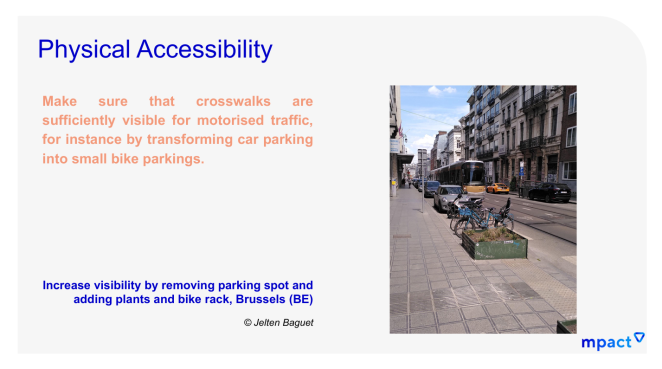The Hub Inclusivity Test (HIT) helps cities evaluate how accessible their shared mobility hubs are for all users. Alongside the test, a recommendations document provides practical guidance and real-world examples to improve hub inclusivity. Assess your hub and explore best practices to make shared mobility truly accessible.
Shared mobility hubs are a key part of reshaping urban transport, reducing car dependency, and encouraging a shift toward more sustainable mobility options. But for shared mobility to be a real alternative for everyone, hubs must be designed with inclusivity and accessibility at their core. If they are difficult to use, whether due to language barriers, lack of step-free access, or digital payment restrictions, they risk limiting the very shift they are meant to promote.
As part of the ShareDiMobiHub project, which is working to integrate shared mobility hubs into part of our daily mobility, partners are taking an active role in making hubs more user-friendly and accessible for all. To help city planners, mobility providers, and local governments assess and improve inclusivity, project partner Mpact has developed the Hub Inclusivity Test (HIT). This tool provides an indication of how accessible a hub is, highlighting areas for improvement while ensuring that transport infrastructure is truly designed for all. The test does not assess compliance with local legal accessibility requirements but offers valuable insights to guide more inclusive urban planning.
Additionally, a comprehensive document of recommendations and real-world examples is available, providing public authorities with practical guidance on designing inclusive shared mobility hubs based on best practices across Europe.
What does the Hub Inclusivity Test measure?
The test evaluates several critical aspects of inclusivity to ensure mobility hubs do not unintentionally exclude certain users. It focuses on three key areas:
1. Service level - Comfort, safety, and accessibility
A mobility hub should be welcoming and safe for all users. The test examines factors such as:
- Seating and shelter – Are there benches and covered waiting areas, particularly in locations with infrequent public transport?
- Availability of staff – Can users access real-time assistance at larger hubs.
- Payment methods – Are there alternatives to app-based or digital payments for those with limited digital literacy?
- Security measures – Is there sufficient lighting and surveillance to enhance user safety, particularly at night?
2. Physical accessibility - A barrier-free and navigable environment
Hubs should remove physical barriers and ensure smooth movement for all users. The test assesses:
- Step-free access – Are ramps and elevators available for people with reduced mobility?
- Visual and tactile aids – Are guiding lines, tactile paving, and auditory signals available for visually and hearing-impaired users?
- Seamless transfers – Are transport modes well integrated, or do users need to cross busy streets or navigate obstacles to switch modes?
3. Communication & information provision - Clarity and accessibility for all
Information at a hub should be clear, easy to understand, and accessible to all users, regardless of language or digital skills. The test evaluates:
- Recognisable signage – Are pictograms used instead of text-heavy signage?
- Multilingual accessibility – Is essential hub information available in multiple languages?
- Digital and non-digital access – Are ticketing machines and digital screens user-friendly for people with limited digital skills? Are printed materials available for those who cannot access digital displays?

© Jelten Baguet
Why is inclusivity key?
An inclusive mobility hub is not just an added benefit—it is a necessity. If hubs are not designed to be accessible to all, they risk excluding large portions of the population and undermining the effectiveness of shared mobility solutions.
Using the Hub Inclusivity Test, city officers and mobility providers can:
- Identify gaps in their hubs' accessibility and inclusivity.
- Improve the user experience by making transport options more welcoming and easy to navigate.
- Ensure that mobility hubs serve all users, including those with disabilities, language barriers, or limited digital literacy.
Alongside the test, Mpact has developed a detailed recommendations document, featuring real-world examples from European cities that are leading the way in designing inclusive shared mobility hubs. This document includes practical improvements such as step-free access, intuitive wayfinding, and multimodal integration, best practices from cities across Europe, demonstrating successful accessibility solutions and examples of inclusive hubs serving diverse users, from people with disabilities to international visitors and those with limited digital skills.
This tool join the efforts of another Interreg North-Sea project, Shared multimodal Mobility for ALL (SMALL), giving public authorities and operators the tools to deploy inclusive mobility services.
Assess your mobility Hub today
For city planners, mobility providers, and policymakers, this tool provides an essential benchmark for making mobility hubs more inclusive.
Take the Hub Inclusivity Test now!
For more information or to discuss how to improve accessibility at your hubs, contact Jelten Baguet or Tjalle Groen from Mpact.
By making mobility hubs truly inclusive, cities can ensure that shared mobility is an option for everyone, regardless of their abilities or backgrounds.
